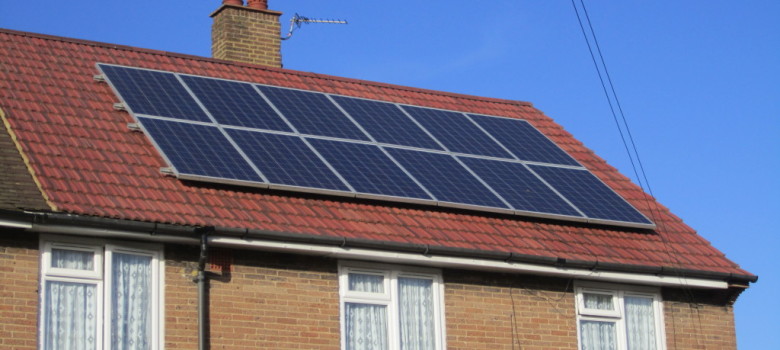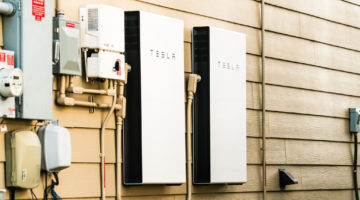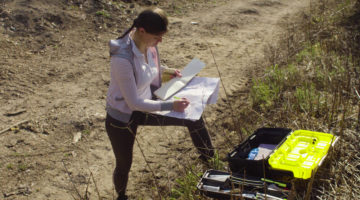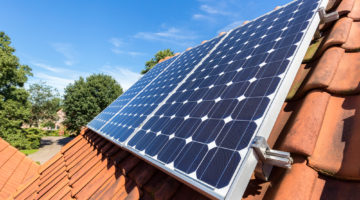
UPDATE: The Feed-In Tariff is now closed for new applications. To find out about the new scheme designed to replace it, click here.
You might be thinking about buying a house with solar PV already installed, or you might have solar PV on your roof and you are looking to sell your property.
In the article below we look at whether solar PV increases the value of the home and some of the factors at play.
Does solar PV really increase the value of my home?
Solar PV is still a very attractive option for many homeowners. Despite the fall in the feed-in tariff, the price of solar panels has dramatically fallen too, so you can now get a large 4kW solar PV system installed for just £6,000 – back in 2010 the same system may well of cost double that.
To be honest, provided you get it installed by a MCS installer and you can claim the FIT payments then the payback is just 8 years and then you will receive a return of £800 (based on a 3.5kW system) for another 12 years after that (so 20 years in total). So from a pure investment point of view – the solar PV is surely a shrewd one.
Effect of the feed-in tariff on value of your home
One thing that people don’t tend to take into account is the effect of solar PV on the value of their property. Now the feed-in tariff payments go to the resident of the home (or the investment company when you consider the solar rent a roof schemes). This means that that you will get a physical financial return for 20 years after installing the payments. If you sell your house 2 years after you have paid for the solar PV installation then the new residents will take over this payments – they will have bought a cash generating asset when they bought the house. This should therefore help increase the value of the house, although the extent to which it does depends on when the new residents moved in. Obviously the sooner you sell the property having invested in the solar panels, the more the install is worth to the new owner.
The distance you are through the Feed-in tariff therefore has a huge impact on the value of your solar PV system and the value of the house as a whole when you come to sell it on. This doesn’t even take into account the savings produced on you energy bills since you can use the electricity you produce meaning you don’t need to buy it from the grid at a cost of 15 per kWh.
When did you get the solar system installed?
Not only does the distance through the feed-in tariff play a large part on the value that the solar system adds to your home – the year the solar system was installed also impacts this.
The reason for this is the feed-in tariff payments have reduced over time, so in October 2011, the amount paid for each unit of electricity produced from the solar system was 43.3p / kWh. Now (January 15) the rates are just 13.88p / kWh. In addition the payment used to be made for a total term of 25 years. Now the feed-in tariff is just paid over 20 years.
This means that if the solar system was installed prior to October 2011, then the value of the system (and therefore the impact it will have on the value of the house as a whole) is much higher.
 Was the system installed with one inverter or micro inverters?
Was the system installed with one inverter or micro inverters?
When the solar industry took off (about the same time the feed in tariff was introduced coincidentally!), most solar PV systems were installed with one string inverter.
There are several issues with these string inverters – including efficiency of the system; basically each panel would operate at the level of the worst operating panel. The issue here though is that the high voltages going through these inverters mean they don’t last too long – in fact they last about 10 years. Therefore they need to be replaced at a cost of about £1,000.
>> String inverters versus micro inverters <<<
Solar PV systems with Micro inverters installed not only have higher efficiency (electrical output), they also last for much longer because the voltages going through them is not as a high. The warranties on these tend to be in excess of 20 years – so obviously this means lower maintenance costs for the incoming occupant, therefore the system is worth more to the incumbent!
The cost of electricity
Another point to consider is the cost of electricity over time. Now this is very difficult for us to predict. At the time of writing the cost of oil is falling almost daily and as a result the cost of energy, and electricity is reducing. This is on the back of consistent 10% annual increases in energy bills we have seen over the last 8 years.
Based on historic trends we are pretty confident that the cost of electricity will increase over time, this means that energy savings today cash wise (produced from using the free solar) will be smaller than in the future.
i.e. 2000 units of electricity might cost £300 today, but 2000 units in 5 years time might cost £500.
Obviously this will make solar systems a far more attractive proposition in the future.
Insuring your solar system
The final point to consider is the costs associated with having solar panels on your roof – you may, for piece of mind, decide to insure your solar system. At a yearly cost of £250 to cover damage, theft and loss of revenue (from the feed-in tariff), that will make a sizeable dent in the revenue that you get from the feed-in tariff – obviously not everyone will take up the insurance (some people will just bear the risk), but it might be worth considering!
So there you have it – the value that solar PV adds to your home varies considerably depending on when the system was installed and also the type of system. If you still have a decent amount of time to run on the feed-in tariff though, as a cash-generating asset, it really should add to the property value.












Installing solar panels not only helps you fetch a higher asking price, but it can also help your home sell 20% faster as properties without solar installations. As electricity prices go up (as they most certainly will), the advantages of solar energy rise proportionally as well.
I bought our house with a 3.8KW solar system on the roof. For us it is perfect since the system had been in place only 3 years so we benefit from quarterly fit payments and free electricity. Didn’t know that about the inverter though. Thought that would last for the lifetime of the solar system
Hi Jez, Sounds like you could have landed on your feet there! If it was installed 3 years ago – this was about the time the Feed-in tariff was 43p per kWh, so not only will you have got this rally good rate, it is also locked in for 25 years (now the FIT is only paid over 20 years).
Well done for reading the article and passing it on as your knowledge.
Hi Chris, considering I wrote the article in the first place I feel as if I am in a position to do that!
Hi James I think the FIT went down in March 2012,as we had ours installed a week before it went down and had to wait for a decision on the price we would be paid. We got the 43p rate, but my brother had his fitted three weeks later and only got 19p.
The 43.3p per unit has increased with inflation and is worth a fraction under 50p now (when the back-to-the-grid payment is included) My system cost £15,500 four years ago but I got over £1,800 in FIT last year.
Solar is a fantastic investment,more people are now understanding the concept more we had a 4kw system installed by a local company & it only cost £5100,1st year i recieved total savings of £933.
The company i brought from was Dynamic Solar Installations in Cambridge 01223653165 maybe you should give them a call(mention me as I will get a £50 finders fee)
I have to agree with Audrey that yes, a home’s value will increase with a solar PV installed. Sellers can demand a higher asking price which most buyers are willing to fulfill since it is a worthwhile investment anyway. Its always better to spend a little more for solar power than to pay for expensive electric bills.
Mark
You have not mentioned the choice of solar PV panels from a rating and efficiency point of view.
For example, on a fairly small roof, I have had fitted 11 Sunpower panels rated at 327W with Solar Edge Connectors giving me a max rating of 3.6kWp. The Solar Edge Connectors monitor each panel so that if one panel is shaded the others still produce power. My system does not slow down to the speed of the ‘slowest ship’ as the article suggests for other installations. Sunpower guarantee the panels for 25 years, the inverter is guaranteed for 12 years. Longevity for the Inverters also depends on where they are sited and the ambient temperature in the location. I also have the ability to interrogate my system to monitor performance.
A little more expensive but well worth the investment.
Hi Martin,
We recommend most people install with micro-inverters now – these come with 25 year warranties in the most part so will last the lifespan of the system. Microinverters mean that all the panels work independently from one another so shading isn’t really a problem anymore.
I have lease solar panels, mortgage companies do not like them.
Hmmm… So home owners are expected to fork out some £6,000 for the panels and installation, and not break even until approx 8 years have elapsed!! Of course, they do get subsidised electricity but offset against that they could have to pay for a faulty micro inverter anytime from the 12 to 20 year mark. Sounds like the benefit is’slim’. Would have been nice to are some factual figures on’actual cost’ vs ‘actual income’ plus’liability cost risks’.
Then, if you are obliged to move within 6 years of installation, you might never recover the installation costs in the sale price of the house, which will result in a loss!
They may added to the value of the house, but many buyers are not too keen on the looks of solar panels on their roof. Also, who pays if the wind rips the panels off and send then through the neighbours conservatory, or if an inverter catches fire in your loft?
All told, if you have £6,000 to spare, it may be a safer bet to invest it elsewhere, and in a way that you can access it at shorter notice, without having to wait 8 years to break even.
I strongly suspect that you are the sort of person who hunkers down by the TV to avoid the risk of being run over on the way to work.
Solar halves your electricity bill, gives you a tax free inflation linked 5% return (worth 6%) on your £6K. You can charge up batteries for free, mowers, a car, Dysons and any number of battery powered devices. You can also get a whopper battery to run your entire house from inc all your hot water and you can keep the subsidy when you move house, but the new occupier gets the free electricity. It’s actually a no brainer if you have the £6K earning less than1%.in the bank.
A pretty good synopsis there Sunny Jim – like it!!
Solar panel is one of the best additions that you can have in your home, specially if you are planning to sell it after dome years. It can be attractive to possible buyers, plus the chance that you can increase the price of your house.
If it takes a number of years for the cost to be recuperated, maybe it’s not the best option just before you move. However, if you’ve just moved into the property, that may be the best time to invest in solar panels – when the time does come to sell, you’ll be ready to reap the rewards.
I think on paper the benefits of solar panels speak for themselves, They’re a massively beneficial addition to any home. Unfortunately some people simply cant see past how they look – they can be quite an eyesore according to some home buyers.
The article is truly an interesting one as it sheds a considerable amount of light on an important matter. These days, so many people are going for installing solar panels in their homes and derive benefits from that. The author discusses at length the facilities that a homeowner can get after installing solar panels in the home. Solar system increases the market value of a residential property, depending on the type of the system and the number of years that have already been passed after the installation. I really got to know a lot of things from this piece of writing and for me, it was both an enjoyable and enlightening read.
It’s June 2018 now I’ve some contribution to make to this thread regarding the recent phenomenon of selling FIT contracts and what to me seems to be ignorance within the surveyor/valuation community.. .A valuation surveyor (Amitstead & Barnett of Garstang) has told me
“you are very adamant that the solar panels are a valuable commodity, however, in our view they simply are not. Many purchasers will in fact be put off by them as to some people they are unsightly and come with maintenance and hassle that for some. offsets the income stream.)”
I just don’t understand. how they can take this position ? Does anyone else ?..Is this some RICS recommended opinion ?
Any one buying my house would be able to sell the FIT contract the very next day in the region of £11,000 – £12,000, they would still receive free clean renewable electricity for ever, I have an immersun controller so that ensures free hot water /storage heater for most of the year, most FIT purchase schemes have free maintenance of the installation for the remaining time (20years in this case).
If they chose not to sell the FIT they would receive £1500 per year FIT payment they would still receive up to 30kwh (on best day) of free clean renewable electricity per day for ever.
On this house the solar panels are not visible and protect the roof on the southwest elevation from the prevailing weather.
Living in the North of England no doubt the impact on house value is less than the sunny south, but surely this is not something which can be legitimately ignored by estate agents and valuers ???